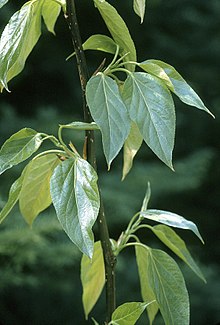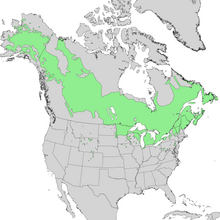Populus balsamifera
| Populus balsamifera | |
|---|---|

| |
| A stem with young leaves | |
| Scientific classification | |
| Kingdom: | Plantae |
| Clade: | Tracheophytes |
| Clade: | Angiosperms |
| Clade: | Eudicots |
| Clade: | Rosids |
| Order: | Malpighiales |
| Family: | Salicaceae |
| Genus: | Populus |
| Section: | Populus sect. Tacamahaca |
| Species: | P. balsamifera
|
| Binomial name | |
| Populus balsamifera | |

| |
| Natural range | |
| Synonyms[2] | |
| |
Populus balsamifera, commonly called balsam poplar,[3] bam,[4] bamtree,[2] eastern balsam-poplar,[5] hackmatack,[2] tacamahac poplar,[2] tacamahaca,[2] is a tree species in the balsam poplar species group in the poplar genus, Populus. The genus name Populus is from the Latin for poplar, and the specific epithet balsamifera from Latin for "balsam-bearing".[6]
Populus balsamifera is the northernmost North American hardwood, growing transcontinentally on boreal and montane upland and flood plain sites, and attaining its best development on flood plains. It is a hardy, fast-growing tree which is generally short lived, but some trees as old as 200 years have been found.[7]
The tree is known for its strong, sweet fragrance, which emanates from its sticky, resinous buds. The smell has been compared to that of the balsam fir tree.
Taxonomy
[edit]The black cottonwood, Populus trichocarpa, is sometimes considered a subspecies of P. balsamifera[8] and may lend its common name to this species, although the black poplars and cottonwoods of Populus sect. Aigeiros are not closely related.
The balm-of-Gilead (Populus × jackii), also known as P. × gileadensis, is the hybrid between P. balsamifera and the eastern cottonwood (P. deltoides), occurring occasionally where the two parental species' ranges overlap. This hybrid is also sometimes planted as a shade tree, and sometimes escapes from cultivation.[9] The name Populus candicans has been variously used for either P. balsamifera or P. × jackii; it is currently considered a synonym of P. balsamifera.
Uses
[edit]The light, soft wood of Populus balsamifera is used for pulp and construction.[7] The resinous sap (or the tree's balsam) comes from its buds, and is sometimes used as a hive disinfectant by bees.[10]
Branches containing the resinous buds are sometimes blown to the ground by spring windstorms, and herbalists from many cultures seek these out to make medicine from them. These sticky spring buds are a highly prized ingredient in medicinal salves and other herbal preparations in both Indigenous North American and European herbal traditions.
Many kinds of animals use the twigs of Populus balsamifera for food. The leaves of the tree serve as food for caterpillars of various Lepidoptera. See List of Lepidoptera that feed on poplars.
References
[edit]- ^ Stritch, L. (2018). "Populus balsamifera". IUCN Red List of Threatened Species. 2018: e.T61959749A61959757. doi:10.2305/IUCN.UK.2018-1.RLTS.T61959749A61959757.en. Retrieved 7 October 2022.
- ^ a b c d e "Populus balsamifera". Germplasm Resources Information Network. Agricultural Research Service, United States Department of Agriculture.
- ^ NRCS. "Populus balsamifera". PLANTS Database. United States Department of Agriculture (USDA). Retrieved 31 January 2016.
- ^ Peattie, Donald Culross. 1991. A Natural History of Trees of Eastern and Central North America. Boston: Houghton Mifflin Company, p. 100.
- ^ BSBI List 2007 (xls). Botanical Society of Britain and Ireland. Archived from the original (xls) on 2015-06-26. Retrieved 2014-10-17.
- ^ Earl J.S. Rook (2006-03-04). "Balsam Poplar, Populus balsamifera". Natural History of the Northwoods. Rook.org. Archived from the original on 2012-08-22. Retrieved 2012-08-30.
- ^ a b Zasada, John C.; Phipps, Howard M. (1990). "Populus balsamifera". In Burns, Russell M.; Honkala, Barbara H. (eds.). Hardwoods. Silvics of North America. Vol. 2. Washington, D.C.: United States Forest Service (USFS), United States Department of Agriculture (USDA). Retrieved 30 August 2012 – via Southern Research Station.
- ^ NRCS. "Populus balsamifera". PLANTS Database. United States Department of Agriculture (USDA).
- ^ Werthner, William B. (1935). Some American Trees: An Intimate Study of Native Ohio Trees. New York: The Macmillan Company.
- ^ "Native Tree Of The Week - Balsam Popular". DeVos Tree Care. Jan 14, 2019.


